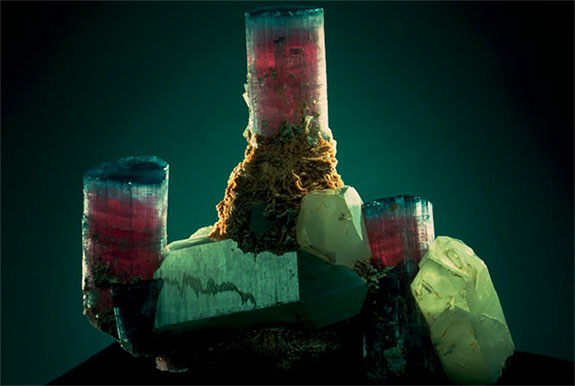How Pala's Bill Larson Pulled the 'Candelabra' From the Tourmaline Queen Mine
In 1972, 26-year-old Bill Larson set out on an evening excursion to the Tourmaline Queen Mine in the foothills of northern San Diego County and returned hours later with the "Candelabra," a piece so magnificent that it currently resides at the Smithsonian in Washington, DC.

The specimen is more than a foot wide and looks like three hot pink candles in a quartz and albite candelabra. It is arguably one of the world's finest examples of October's official birthstone. (Opal is October's other official birthstone.)
The Candelabra is the most exceptional piece from a strike that exposed brilliant rubellite crystals in what was called “the find of the century in terms of color and perfection.” The Tourmaline Queen Mine soon became one of the world's prime sources for fine tourmaline and put Pala Properties International (now Pala International) on the map.
The tourmaline family consists of more than 30 distinct minerals, but only one — elbaite — accounts for nearly all of the tourmaline gemstones. Varieties of gem-quality elbaite include rubellite (red-pink), indicolite (blue), Paraiba (neon greenish-blue) and the multicolored watermelon (pink surrounded by green).
In an article published in a 1972 edition of Lapidary Journal, Pala International's president shared a first-hand account of how he carefully extracted the "Candelabra" earlier that same year…
"The Main Find," as Larson described it, was unearthed in two sessions.
He recalled how he had exposed a nice single tourmaline earlier in the day, and then returned to the mine later — with his father's permission — to dig it out. The evening's activities would be no cake walk, however. The generator that was supposed to light the way was malfunctioning so he and his co-worker, Carl, had to manage using a large flashlight.
"As we got to the pocket, I forgot our troubles as the red translucence shone back at us through the crystal I had exposed earlier," he wrote.
He used a sledgehammer and a chisel to "chip, chip, chip" away at the pocket.
"The work went on so slowly, and I was further slowed by the cramped position," he continued. "To get the results I wanted took the better part of an hour."
As he removed the clay around the specimen, a quartz crystal was evident behind the tourmaline. They appeared to be attached.
"My heart raced," he wrote. "I felt a tremendous urge to rip the piece out to look at it, but I forced myself to use restraint and to continue to work completely around it."
He moved material methodically as the complete specimen took shape.
"It was really quite large, over a foot, then at the rear I found a second tourmaline attached. I knew then we had a great piece," he added.
When he was ready for the final removal, Larson placed a small bar in the center and applied gentle pressure.
"I could feel the entire mass move. What a thrill!" he recalled. "I reached in with both hands and pulled out the now famous 'Candelabra' specimen."
It measured more than a foot long and had two tourmalines on either end. Larson also notice that in the center-top of the piece there was a place where a third tourmaline had once been attached.
"We dug for about 40 minutes more and found the third tourmaline. It was a perfect fit. This was a fabulous specimen, one of the finest ever," he wrote.
When he and Carl returned to the shop they knew the Candelabra would some day grace the halls of the Smithsonian — and they were right.
Credit: Photo by Chip Clark / Smithsonian.

The specimen is more than a foot wide and looks like three hot pink candles in a quartz and albite candelabra. It is arguably one of the world's finest examples of October's official birthstone. (Opal is October's other official birthstone.)
The Candelabra is the most exceptional piece from a strike that exposed brilliant rubellite crystals in what was called “the find of the century in terms of color and perfection.” The Tourmaline Queen Mine soon became one of the world's prime sources for fine tourmaline and put Pala Properties International (now Pala International) on the map.
The tourmaline family consists of more than 30 distinct minerals, but only one — elbaite — accounts for nearly all of the tourmaline gemstones. Varieties of gem-quality elbaite include rubellite (red-pink), indicolite (blue), Paraiba (neon greenish-blue) and the multicolored watermelon (pink surrounded by green).
In an article published in a 1972 edition of Lapidary Journal, Pala International's president shared a first-hand account of how he carefully extracted the "Candelabra" earlier that same year…
"The Main Find," as Larson described it, was unearthed in two sessions.
He recalled how he had exposed a nice single tourmaline earlier in the day, and then returned to the mine later — with his father's permission — to dig it out. The evening's activities would be no cake walk, however. The generator that was supposed to light the way was malfunctioning so he and his co-worker, Carl, had to manage using a large flashlight.
"As we got to the pocket, I forgot our troubles as the red translucence shone back at us through the crystal I had exposed earlier," he wrote.
He used a sledgehammer and a chisel to "chip, chip, chip" away at the pocket.
"The work went on so slowly, and I was further slowed by the cramped position," he continued. "To get the results I wanted took the better part of an hour."
As he removed the clay around the specimen, a quartz crystal was evident behind the tourmaline. They appeared to be attached.
"My heart raced," he wrote. "I felt a tremendous urge to rip the piece out to look at it, but I forced myself to use restraint and to continue to work completely around it."
He moved material methodically as the complete specimen took shape.
"It was really quite large, over a foot, then at the rear I found a second tourmaline attached. I knew then we had a great piece," he added.
When he was ready for the final removal, Larson placed a small bar in the center and applied gentle pressure.
"I could feel the entire mass move. What a thrill!" he recalled. "I reached in with both hands and pulled out the now famous 'Candelabra' specimen."
It measured more than a foot long and had two tourmalines on either end. Larson also notice that in the center-top of the piece there was a place where a third tourmaline had once been attached.
"We dug for about 40 minutes more and found the third tourmaline. It was a perfect fit. This was a fabulous specimen, one of the finest ever," he wrote.
When he and Carl returned to the shop they knew the Candelabra would some day grace the halls of the Smithsonian — and they were right.
Credit: Photo by Chip Clark / Smithsonian.

